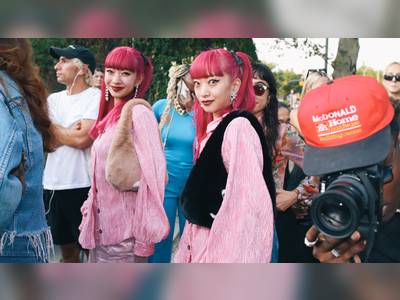Day after day, dour predictions about the economy have prompted warnings that consumers will be tightening their metaphorical belts. That makes it hard to put a fur coat on the runway and try to convince retailers, editors and stylists that the look will be all the rage next season.

The Fall 2008 collection by Carolina Herrera is modeled during Fashion Week in New York, in this Monday, Feb. 4, 2008 file photo. Designers including Herrera have used feathers as a more understated adornment. (AP Photo/Diane Bondareff, FILE)
Fashion insiders, though, are mixed on how to handle the grim financial news. While some have focused on go-anywhere basics and investment-worthy outerwear, others are working extra hard to find look-at-me trends or small bits of understated luxury that women might find worthy of their limited pocket money.
Michael Fink, fashion director at Saks Fifth Avenue, said he was focused on finding clothes women don't already have in their closets.
"No basics — that's my mantra. No basics," Fink said. "The whole industry is looking at things with a fine eye at price points, but, as a luxury-brand store, we're still interested in luxury products."

A model walks the runway during the presentation of Proenza Schouler's Fall 2008 collection in New York in this Monday, Feb. 4, 2008 file photo. Mustard yellow, as seen here, is among the muted colors common at Fall Fashion Week. (AP Photo/Kathy Willens, FILE)
On the runway so far this week, luxury has had a subdued presence in feather adornments, a little bit of fur, and beading or metallics added to knits and tweeds. There seems to be a concentrated effort to present more daywear instead of evening gowns, and the colors are fairly subdued, with a palette rooted largely in black, purple, dark blue, mustard yellow and green.
Men's clothes, meanwhile, were built around the suit, albeit a slim, narrow one.
"I think when there's sort of an economic downturn looming, at least men tend to be a bit more conservative and they want to return to tradition," said Perry Ellis creative director John Crocco.
Off the runway, there were few signs that times are tough.
Gucci footed the bill for a celebrity-studded gala at the United Nations Wednesday night and opened up its biggest store in the world on Fifth Avenue. The store covers 46,000 square feet, with marble floors, walls covered in bronze glass and mirror, and a free-floating staircase. It includes a special VIP shopping area.
Max Azria, founder of the Max Azria BCBG Group, had shown two collection on the runway at Mercedes-Benz Fashion Week in recent seasons but this time added a third: the Herve Leger label that he's trying to resurrect. Runway shows at Bryant Park cost tens of thousands of dollars each.
"We believe the downward economic change will affect the already weak businesses but improve the strong ones. We are the latter," Azria said.

Models display Fall fashions from Narciso Rodriguez during Fashion Week in New York in this Tuesday, Feb. 5, 2008 file photo. Dark colors and lean silhouettes as seen at Rodriguez's show may reflect the mood of the economy. (AP Photo/Seth Wenig, FILE)
Derek Lam was also unconcerned about any downturn: "Beauty, I think, is recession-proof."
Still, it's hard not to think of the economy when looking at all these expensive clothes, said Linda Wells, Allure magazine's editor in chief. It's part of her job to find balance in the pages of her magazine between items readers aspire to have and those they can actually afford.
Even wealthy people whose discretionary spending isn't affected by a dip in the economy are unlikely to be as showy about their wealth in bad times, Wells predicted.
That might be why feathers stole a lot of fur's thunder, she added — they're simply not as flashy, if not cheaper. (Feathers are notoriously labor intensive.)
"It doesn't look ostentatious. All that ridiculous bling and `it' bags — there will be a shift away from that," she said.
Of course, women will shop for clothes even in hard times, but they might choose one or two new-but-classic dresses instead of a closet full of trendier items, said Suze Yalof Schwartz, Glamour's fashion editor at large. They want clothes that look expensive but not over the top.
That may be why many designers are focusing on chic outerwear: A coat will get more wear than any other piece of clothing. Yalof Schwartz also suggests buying a well-made belt to cinch the waist of an old coat.
"The `it' bag has been replaced by the `it' belt," she said.
Saks' Fink praised the continuation of the layered look, which works for all climates — an important factor since half of Saks' stores are in the South. Plus, he noted, people feel good about "seasonless" clothes. They can wear them year-round so they seem a wiser, practical purchase.
But if fashion is any indication, concern about the economy hasn't reached a boiling point.
"When the economy is good, hem lines go up. When the economy is bad hemlines go down," said Cynthia Rowley.
Her hemlines are longer in the fall collection — but that parted ways with most designers at Fashion Week, who seized on miniskirts.
"I think we'll — not to use a bad fashion term — but we'll probably skirt a real recession," she said. "I have been following all the political coverage really carefully and closely. ... I think people are cautiously optimistic, but I still think a little bit nervous."

The Derek Lam Fall 2008 collection is modeled during Fashion Week in New York in this Wednesday, Feb. 6, 2008 file photo. Fur has been used as an accent for a smaller touch of luxury at New York Fashion Week. (AP Photo/John Smock, FILE)













